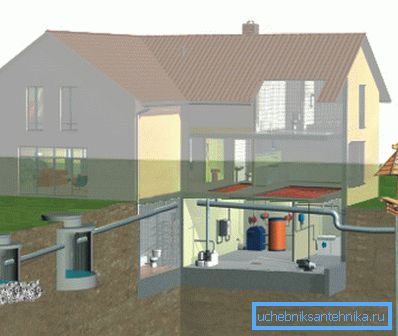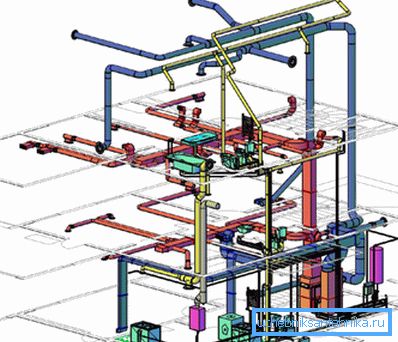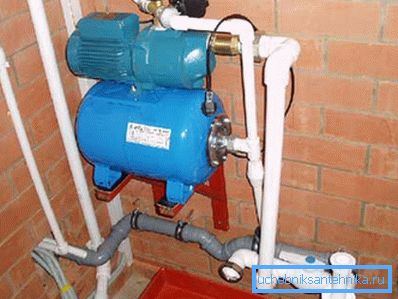Sewerage and plumbing: how to design and install the
No dwelling can provide the necessary level of comfort without the presence of modern engineering networks in it. And if the apartments are often already equipped with the necessary systems, then in a private house, this issue is resolved by each individual. The installation of water supply and sewage systems requires special attention, since the health status of the inhabitants directly depends on these systems.

Varieties of water supply and sanitation systems
A water supply system is a specially designed and designed system, the main purpose of which is to provide continuous water supply to various consumers in a residential or administrative building. Simply put, it is a pipeline with various additional elements (pumps, filters, tanks, and so on) that delivers water of the required quality from the water intake point to the bathroom and kitchen (see also the article Local sewage: ways to successfully implement it).
As for the sewage system, its task is the opposite. It is necessary for the removal of wastewater, their accumulation in special tanks and, in some cases, treatment.
There are special rules and regulations for the technical operation of plumbing and sanitary. The characteristics of these engineering networks must fully comply with them.

Water supply and sewerage according to SNiP are of two main types:
- centralized - water supply and sewage disposal occurs using the existing networks of the settlement;
- autonomous - water intake and waste disposal is carried out using individually installed equipment.
The first option is preferable primarily because the cost of designing and installing all systems will be much lower than when building your own networks. In this case, the installation of water supply and sewerage will consist only in the laying of internal pipelines and their connection to the city communications.
All this is easy to do with your own hands. It is only necessary to obtain the appropriate permission of utilities.
But far from all villages and towns there is a centralized sewer and water supply network. Therefore, we have to design and build our own systems, taking water from a well or a well and filtering drains using a septic tank or a biological treatment station.

The rules of operation of water and sewer networks provide for their division into two large groups.
The classification criterion is a method of transporting a liquid:
- Free-flow In this case, the water flows through the pipes under the action of gravity. All elements must be at a certain angle.
- Pressure head It is used when there is no possibility to design and build a free-flow system (for example, in areas with difficult terrain). In this case, it is necessary to use pumps that pump water.
Note! The pressure system can operate only in the presence of electricity. Therefore, care should be taken to ensure uninterrupted operation of this network. You may need to buy and install an electric generator that provides housing for electricity during accidents.
Water supply and sewage system design
This stage of work is almost more important than the construction itself. It is best to ask for help in special organizations or to specialists with relevant skills and qualifications.
You can undertake this business only if you plan to build a simple scheme for servicing a country house. Otherwise, you may encounter many problems that will need to be spent on a large amount of time and money. Sometimes you need to start the whole process with a clean slate.

First you need to decide on the number and location of water intake points from the water supply system. The simplest option is when the kitchen and bathroom are located in adjacent rooms. In this case, you can use a single sewer riser.
A more complicated case is a two-story or three-story house, each of which also has a toilet or bathroom. It will be necessary to use several risers, and, perhaps, the same cumulative wells or septic tanks.
In addition, it is necessary to carry out other calculations:
- choose a source of water intake - it can be a well, an individual well or just an open reservoir (lake, river);
- to establish the level of groundwater occurrence - works on geological research of the soil may be necessary (the existing engineering and topological drawing of the land plot will also help);
- determine the need for drinking water - is calculated on the day and depends on the number of people (this is required to select equipment of the required capacity);
- select the type of sewage treatment plant or reservoir that will be installed on the site.

Tip! As a last resort, it is recommended to purchase ready-made structures sold in hardware stores. Plastic storage tanks, ready-made septic tanks and biological treatment stations are available.
Installation of engineering networks
Construction of water supply and sewage on the site can be started only after the creation of the project.
It should contain:
- installation sites of various elements, shaped parts and fittings;
- dimensions of certain elements.
To make the developed documentation easier to read, you should use the conventional symbols of plumbing and sanitary. Then for the work additional instructions will not be needed.
Otherwise, there is a danger of using pipes of smaller diameter, other stop valves, and so on. And the wrong distance between the water supply and sewage can even lead to water pollution in the well or well.
Manufacturing of internal pipelines
Construction of plumbing and sewage inside the house begin after the construction of the frame structure, as well as the arrangement of the roof.

We list the main nuances of this process:
- the diameter of the water pipes used is calculated based on the number of water intake points in the house;
- Before entering the pipeline into the house, it is advisable to install a departmental shut-off valve, then accounting equipment, and only after it — a house crane;
- all the main elements of the plumbing and drainage systems (pumps, filters, meters, stop valves, etc.) are installed in the basement;
- It is advisable to provide for the installation of three pumps: the first two provide water at minimum and maximum load, the third - in emergency situations;
- do not forget to observe the pipe slope provided for in the project;
- the distance of the drinking water pipeline from the sewer outlet pipe and other pipelines (gas, heating) must be at least 1.5 meters.

Tip! Even if you are taking water from a well or well, it is recommended not to neglect the installation of water metering equipment. So it will be easier to take into account costs in natural and monetary terms. In addition, it can be used, for example, to calculate the amount of water needed to fill the pool, artificial pond, and so on.
External system gasket
As for the engineering networks, laid outdoors, here you need to pay attention to such moments:
- The depth of the pipe-laying trench must exceed the distance the soil freezes through in winter. This will prevent freezing of water and rupture of the pipeline.
- When crossing the water supply and sewerage, the distance between the pipes should be more than 40 cm in height. In addition, a special steel casing should be equipped for this site, protecting the pipes for a distance of 5 to 10 meters (depending on the nature of the soil).
- Crossing pipelines should only be performed at a right angle.
- The distance between the parallel paved pipelines must be at least 1.5 meters.

Conclusion
Remember that not only the duration of their operation and the absence of accidents depend on the correct observance of all requirements when laying engineering networks in a private house (see also the article Autonomous sewage in a private house: choosing the best option).
More details about the development and design of water supply and wastewater networks can be found in the video in this article.